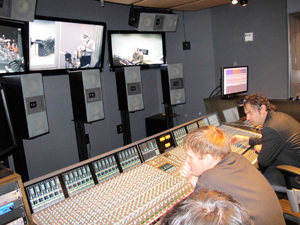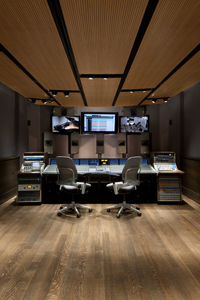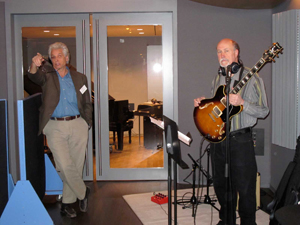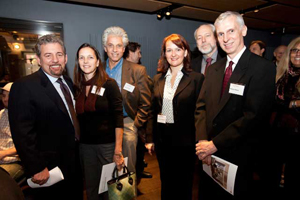Scofield Session Launches NYU’s New Storyk-Designed Studio Complex
GREENWICH VILLAGE, MANHATTAN: NYU’s Department of Music and Performing Arts Professions at the Steinhardt School just cut the ribbon on a new 7,500-sq-ft recording studio and music production/educational complex. SonicScoop was there on opening day, and toured the new “James L. Dolan Music Recording Studio,” as John Scofield & ensemble warmed up for the facility’s inaugural session.
This recording studio and research/learning center is a Walters-Storyk (WSDG) design (Electric Lady, Allaire, Jazz At Lincoln Center, etc.), made up of multiple sound-treated environments around a central control room that boasts a 10.2 surround monitoring environment.
The facility takes up the entire 6th floor of the Steinhardt building on W. 4th Street and its design allows multiple configurations — it can accommodate one massive session or several smaller projects and research activities for the Department’s Music Technology, Scoring for Film and Multimedia and Jazz Composition and Performance programs.
How’s that? Well, most rooms within the complex, including the lecture/lab rooms, have been treated for acoustics and patch into that one main control room, which also seats classes of up to 25. All told, there are six large isolated tracking rooms with variable acoustics. Plus, the studio ties to the 300-seat Frederick Loewe Theater via MADI (Multichannel Audio Digital Interface: an AES standard format that’s transmitted over thin fiber optic cable) and will likewise be able to record from NYU’s new Provincetown Playhouse on MacDougal.

Paul Geluso at the SSL Duality (far right) pictured, with front range of Lipinski surround speakers and video monitoring of the tracking environments, Scofield pictured center.
“We have MADI down to the [Frederick Loewe] theater, with 48 channels of digital and 32 channels of analog coming back up via fiber,” says NYU’s chief systems engineer/adjunct professor Tom Beyer.
“We’ll have MADI over at the Provincetown Playhouse as well, so we’ll be able to roll our remote case — equipped with four Millennia Media remote controlled mic pres and two SSL Alpha MADIs — down there and track 48 channels of audio from that room to our control room here.
“And on Third Avenue, we’re also re-doing a home for Jazz and Piano Studies. That’ll also have fiber, so we’ll be able to record that room from here as well. It’s great because we can work from this control room, a space we know really well, and control all the preamps from here. Just need someone on site to move the mics around!”
Providing The Academic Edge

Control/class room with SSL Duality and Lipinski speakers. Photo by Cheryl Fleming Photography: http://www.cherphotos.com/architecture%5B/caption%5D
In the control room, a 48-channel SSL Duality integrates with Pro Tools HD3 on a Mac G5, which also runs Logic, Digital Performer and Max/MSP. A Dangerous Music Monitor ST/SR and 10 Lipinski L-707 mains and L-150 subs provide a unique and cutting-edge experience in surround sound — the room can be configured for 5.1 and up to 10.2 surround monitoring.
“The 5.1 to 10.2 set up came about after a lot of brainstorming about essentially what would be the most flexible configuration,” says WSDG co-principle John Storyk. Dave Kotch, project engineer for WSDG and Masque Sound, which did the audio gear installation, notes of the Dangerous ST/SR, “Since the SSL only has 5.1 surround, we need this piece to make everything work with the Crestron control system and BSS Soundweb processors for 10.2.”
As for the Lipinski speakers, WSDG project manager Josh Morris adds, “I usually recommend a short list of speakers and the client will compare in critical listening sessions. When you don’t need to achieve urban music monitoring levels, a different universe of speaker opens up to you.”
Beyer adds, “Leszek Wojcik, the chief engineer at Carnegie Hall who teaches the “Aesthetics of Recording” class for us, hipped Paul Geluso [producer/engineer and NYU professor] and I up to these speakers; we went and heard them at AES in NYC two years ago and were really impressed. Paul subsequently bought a pair. We did some critical listening, and the Lipinski’s came out on top.”
No Opening Day Jitters
 Figure 4: John Storyk (left) explains the acoustics of the main tracking room and piano room (background), where John Scofield (right) and ensemble were setup to play on opening day!
Figure 4: John Storyk (left) explains the acoustics of the main tracking room and piano room (background), where John Scofield (right) and ensemble were setup to play on opening day!On opening day, the studio was producing a large-scale session with Scofield and ensemble in the main tracking rooms and NYU’s symphony orchestra down on the Frederick Loewe stage.
Off the control room are four tracking environments, which were set up with drums, bass and Scofield on guitar in the main tracking room, piano and horns in isolated rooms. A sliding glass-door isolates the piano room from the main tracking room (as pictured in Fig. 4).
“The live room features convex diffusion with variable acoustics on the sides,” says Storyk. “For instance, by recording piano with the door open, you’ll get a bigger, more open and live sound.”
According to Robert Rowe, vice-chair and director of music composition, Meredith Monk would be in session that night, and regular classes will start using the space in the Spring ’10 semester.

Pictured inside the 16-channel surround lab are Music Technology grad students: (l-r): Chris Polcyn, Izzi Ramkissoon and Kyle Vaughn.
Special projects are already underway, however. Some Music Technology grad students have an interesting project they call “Birds of Prey” (fig. 4) set up in the 3D audio lab (which also doubles as one of the six isolated recording environments). The lab is a 16-channel surround sound environment, using (16) Genelec speakers and two Genelec subs set up on a reconfigurable grid, with multichannel miking, tracking and playback options.
Birds of Prey is a 3D sound experience, where the visitor interacts with the room and ambient sounds created in MaxMSP. One’s movement within the room, which is tracked by camera, triggers and amplifies different sounds, intensifying the immersive experience, which — to me — felt a bit like an underwater aviary. Cool!
Please note: When you buy products through links on this page, we may earn an affiliate commission.







